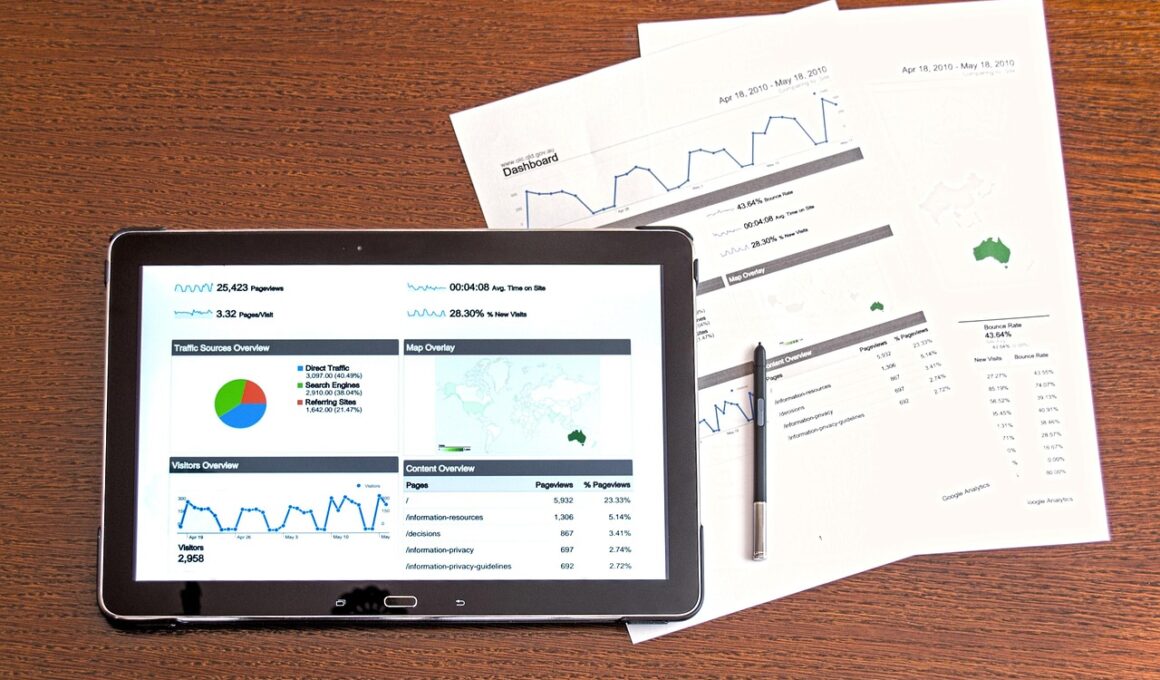Using Analytics to Optimize Influencer Partnerships
Influencer marketing has transformed the way brands connect with their audiences. In this landscape, gathering insights through analytics is vital. Utilizing analytics for influencer partnerships can significantly enhance campaign outcomes. The process begins with establishing clear objectives, such as boosting brand awareness or increasing sales. Tracking performance against these objectives is equally essential. Key performance indicators, such as engagement rates, reach, and conversions, should be monitored consistently. Tools like Google Analytics or dedicated influencer marketing platforms can help aggregate relevant data efficiently. Moreover, it is important to continuously validate influencer performance through audience demographics and engagement metrics. This ensures that the influencers’ followers align with the target market demographics of the brand. Additionally, combining influencer analytics with traditional marketing metrics aids in understanding overall campaign efficacy. Keeping a close eye on industry trends and shifts in consumer behavior allows for real-time adjustments rather than retrospective amendments. Consequently, stakeholders must prioritize communication within teams for aligning all parts of an influencer strategy. Adapting a data-centric approach ultimately cultivates successful influencer relationships and translates into enhanced revenue streams.
One of the primary advantages of leveraging analytics is the ability to pinpoint successful influencers. By analyzing past campaigns, brands can see which partners yielded the best results. Metrics such as engagement rates, audience growth, and brand sentiment provide an overall picture. Once top-performing influencers are identified, companies should consider factors like audience alignment and content style. This tiered selection process ensures that relationships formed will resonate well. Brands must also recognize the importance of testing varied approaches before settling on a strategy. Running smaller pilot campaigns can yield insight on audience reactions without significant investments. For instance, setting a timeline for each partnership analysis allows brands to adapt and refine their tactics. In addition, competitor analysis highlights potential gaps in the market that could be addressed through unique collaborations. Reporting tools are invaluable for visualizing progress and comparing performance across different influencer partnerships. Thus, brands can gauge overall effectiveness, helping them make data-backed decisions. As brands nurture a deeper understanding of data-driven insights, they achieve valuable, long-term influencer collaborations in an increasingly competitive landscape.
Understanding Metrics for Success
To leverage data effectively, it is essential to grasp which metrics matter most in influencer marketing. Different campaigns may value distinct metrics based on their respective goals. Common success indicators include engagement rates, reach, impressions, click-through rates, and conversion metrics. Engagement rates, in particular, indicate how well the audience interacts with influencer content, thus highlighting the overall effectiveness of that influencer. Reach and impressions measure the visibility of content, allowing brands to gauge potential audience touchpoints. Analyzing click-through rates provides insights into how effectively content drives traffic to brand websites or landing pages. On the other hand, conversion metrics allow for measuring sales directly generated from influencer partnerships. It serves as a definitive metric for ROI calculations. Using analytics tools like Hootsuite, HubSpot, or custom dashboards, brands can visualize their influencers’ performances effectively. Furthermore, segmented data offers more precise insights, helping brands understand different audience behaviors. Insights drawn from these metrics should not only guide future influencer selections but also direct campaign strategies and content creation for optimal effectiveness. Establishing a solid groundwork on these metrics paves the way for a more focused and efficient influencer marketing strategy.
Another critical aspect of influencer marketing analytics is audience analysis. Understanding the audience demographics is vital for determining partnership effectiveness. By examining the audience characteristics, brands can assess alignment between their product and the influencer’s followers. Key factors such as age, gender, interests, and geographic location all play an essential role. This data driven approach ensures that influencer marketing strategies are directed towards the right consumer segments. Additionally, analyzing audience engagement and sentiment within posts can enlighten brands about potential challenges or opportunities in messaging. Leveraging social listening tools allows brands to gain insights into audience perceptions beyond direct engagement metrics. Sentiment analysis reveals where the brand stands concerning the influencer’s audience. Consequently, this understanding can guide future content strategy, lending to the unique messaging styles preferred by typical consumer segments. For better results, brands should communicate expected outcomes and insights back to the influencers involved. This two-way communication fosters a more collaborative environment where each party can depend on the other for optimized performance. As relationships flourish, analytics should be continuously updated, ensuring that strategies remain agile in a rapidly evolving market.
Building Long-term Relationships
Analytics enable brands to build and maintain long-term relationships with influencers. Assessing the effectiveness of these partnerships can lead to more strategic collaborations. Tracking influencer engagement over time reveals relationship health, enabling respective teams to adjust as necessary. Creating a feedback loop allows both parties to improve their content strategies based on data. For instance, consistent content performance reviews help guide future campaign directions and partner expectations. Successful partnerships rely on mutual benefit, with brands providing value in return for the influencer’s reach and engagement. Regular check-ins and open communication channels help foster trust and accountability. Likewise, identifying issues early on can prevent campaigns from veering off track. By prioritizing transparency and shared analytics, brands can align goals effectively. Continued investment in influencer relationships leads to opportunities for collaborative initiatives, such as co-branded products or events. As brands adopt a more personalized approach, they can maintain relevance in their influencer strategies. This ultimately results in better consumer engagement. Brands who embrace long-term partnerships backed by insightful analytics consistently see more positive ROI across influencer marketing campaigns.
In summary, using analytics to optimize influencer partnerships is a multifaceted process that demands diligence and clarity. Brands must continuously analyze campaigns to derive meaningful insights that guide future decisions. Establishing initial objectives translates into actionable metrics, allowing brands to measure performance effectively. The journey does not end upon completing a campaign; instead, it requires ongoing reviews and iterative optimizations based on accumulated data. Emphasizing relationship-building and transparency can elevate partnerships beyond transactional interactions. This cooperative approach empowers brands and influencers to be adaptive, responding swiftly to changing market dynamics and audience preferences. By focusing on audience metrics, brands ensure that they are connecting with the right consumers. Regularly leveraging tools and techniques allows businesses to visualize data more effectively and uncover insights that could be easily overlooked. As the influencer marketing landscape continues to evolve, brands must remain committed to data-driven strategies. In doing so, organizations maximize their marketing budgets and see substantial returns on their investment. This commitment to analytics not only strengthens existing partnerships but also opens doors to new opportunities in future influencer collaborations.
Future Trends in Influencer Marketing Analytics
As we look to the future of influencer marketing analytics, various emerging trends will shape how brands engage with influencers. One notable trend is the increased use of artificial intelligence and machine learning in data analysis. These technologies will provide brands with enhanced analytical capabilities, allowing for deeper insights into audience behavior patterns. Additionally, as privacy regulations evolve, brands will need to adapt their data collection strategies while remaining compliant. Influencer marketing platforms are becoming more sophisticated, offering advanced metrics and tools to assist brands in leveraging analytics efficiently. Peer-to-peer influencer networks are on the rise, promoting genuine interactions and organic follower engagement. Investing in authenticity is becoming paramount as consumers grow more discerning about the influencers they follow. Brands should be prepared to conduct thorough vetting processes and focus on influencer personal branding as part of their analytics assessments. Video content will become more prominent, pushing the need to analyze engagement in dynamic ways. Embracing these trends positions brands favorably in an evolving landscape that rewards real connections. As analytics grows in sophistication, so will the insights drawn from influencer partnerships.
Lastly, integrating social commerce with influencer analytics is set to revolutionize marketing strategies. As platforms evolve, they increasingly emphasize shopping experiences, connecting influencers directly with sales metrics. This provides real-time data that can be utilized to optimize campaigns further. Brands should consider adding shoppable posts to influencer-led content, allowing fans to purchase products seamlessly. Optimizing the customer journey from discovery to purchase is crucial for enhancing conversion rates. Ensuring that influencers reflect the brand’s values will bolster credibility and encourage sales. Data coherence across various channels allows brands to measure the effectiveness of influencer collaborations comprehensively. Performance measurements should also take into account cross-platform selling as consumers engage across multiple touchpoints. As the trend toward influencer-led social commerce grows, brands can expect to see exponential increases in sales and engagement. Allocating resources towards learning and adapting new strategies rooted in analytics pays long-term dividends. Forward-thinking brands will keep an eye on consumer trends, ensuring that their approaches remain relevant. Continued innovation in influencer analytics fosters a future where data-driven strategies redefine partnership management and influence marketing success.


